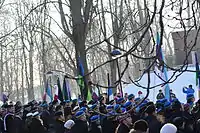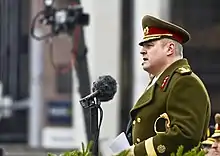Independence Day (Estonia)
Independence Day (Estonian: Eesti Vabariigi aastapäev) is a national holiday in Estonia marking the anniversary of the Estonian Declaration of Independence in 1918. It is commonly celebrated with concerts, parades and parties. It is the national day of Estonia.
| Independence Day | |
|---|---|
 Parade in Tallinn, 2011 | |
| Official name | Eesti Vabariigi aastapäev |
| Also called | National Day |
| Observed by | Estonians |
| Significance | National |
| Celebrations | Concerts, Parades |
| Date | 24 February |
| Next time | 24 February 2021 |
| Frequency | annual |
History
The Estonian Provisional Government decided on 12 February 1919 to consider 24 February to be the date of the declaration of independence. In 1933, the Government discussed whether the national day should be moved to another date at a better time of the year, such as 15 June, to mark the date when the Estonian Constituent Assembly adopted the Constitution in 1920.
Hugo Kuusner requested on 21 February 1937 that the anniversary of the Republic of Estonia should be 23 February, not 24 February. Gottlieb Ney, the director of the National Archives of Estonia said that "… one must reach the conclusion that the 24 February 1918 should be considered the date when the republic began; it is the day when the declaration of independence reached the capital city and actually went to the supreme powers of elected bodies (at that time the Estonian Salvation Committee and the provisional government)."
28 November 1917
On 28 November [O.S. 15 November] 1917 the Estonian Provincial Assembly met in Toompea Castle and proclaimed itself "Estonia's sole bearer of a higher power." The decision not to use the word "state" was adopted by 48 members of the Provincial Assembly present, with 9 abstentions (who were mostly socialist revolutionaries, along with a couple of Mensheviks). The Estonian Provincial Assembly called for Estonian soldiers to immediately and quickly come from all over Estonia. Some sources have referred this date to as "The Real Estonian Independence Day".
23 February 1918
On 23 February 1918 the Manifest of All Peoples was published in Pärnu which declared an independent and democratic Republic of Estonia.
23 June 1919
On 23 June 1919 in the Estonian War of Independence, troops during the Battle of Võnnu defeated a German division. This event is celebrated in Estonia as Victory Day.
2 February 1920
On 2 February 1920, Estonia and Soviet Russia signed the Tartu Peace Treaty which made Estonia a de jure independent state.
16 November 1988
On 16 November 1988, the Supreme Soviet of the Estonian SSR adopted the Estonian Sovereignty Declaration, which asserted Estonia's sovereignty and the supremacy of the Estonian laws over the laws of the Soviet Union.
30 March 1990
On 30 March 1990, the Supreme Soviet of the Estonian SSR adopted the resolution "On The State Status of Estonia", whereby it declared Soviet rule in occupied Estonia to have been illegal since the start and declared a period of transition to restore the Republic of Estonia.
8 May 1990
On 8 May 1990, the Supreme Soviet of the Estonian SSR, during the last day of its existence, declared the Estonian Soviet Socialist Republic invalid and re-established the Republic of Estonia. The government adopted a law on "the symbolism of Estonia" according to which Estonia's national colors are blue, black and white. Paragraphs 1,2,4,5 and 6 of the Constitution of Estonia stated that "Estonia – separate and independent state, the rule of power which is its people." Attempts to preserve the Soviet Union on the basis of a confederal agreement proposed by Moscow were rejected by the Estonian leadership.
20 August 1991
On 20 August 1991, during the attempted coup in Moscow by the hardline Communist Party members, the Soviet 76th Guards Air Assault Division arrived in Tallinn. Volunteers organized protection of Toompea and the television broadcast tower. The Popular Front of Estonia organized a rally in Freedom Square which called for the independence of Estonia. On the same day, late in the evening at 23:02, the Supreme Council of Estonia, along with the leadership of the Estonian Committee agreed on “the independence of the Estonian state and the establishment of the Constitutional Assembly", thus proclaiming the restoration of Estonian independence.[1][2]
Celebrations

The President of Estonia organises a festive Independence Day reception at which state decorations are awarded to recipients whose names are published in advance. Since the restoration of Estonian independence in 1991, a new tradition of parades by the Estonia Defence Forces has been established, with the first parade held in Tallinn in 1993 marking the diamond jubilee year since the events of 1918. Both the parade and the reception is held in different years in different cities; in 2014 they were held in Pärnu, and in 2015 in Narva, with that year's parade featuring contingents from fellow NATO member nations. The parade, the reception and a concert that precedes the reception are broadcast live on television. This coverage includes a speech by the President. The reception line, where the President and their spouse shake hands with attendees is called the "Penguin Parade". As the President's reception is always organized on 24 February, similar local receptions are often held earlier on 23 February. Schools and other institutions sometimes hold events even earlier. In recent years, it is customary that the Prime Minister must call in Vanemuine at the Tartu reception.
The Estonia celebrated its 100th anniversary on February 24, 2018. The centenary is marked from April 2017 to February 2020.[3]
Military parade
First held in 1993, the annual EDF military parade is held on Tallinn's Freedom Square. On the morning of the holiday, the ground column consisting of infantry and armoured formations marching through the square from the Land Forces, Navy, Air Force, and the Defence League form part of the parade. Outside of the military, the police and other cadet and paramilitary youth organizations are represented.


The following organizations send units and formations to the parade:
- Estonian Military Academy (KVÜÕA)
- Baltic Defence College
- Guard Battalion
- Headquarters Support and Signal Battalion of the Küberkaitseliit
- 1st Infantry Brigade
- 2nd Infantry Brigade
- Support Command
- Special Operations Force
- Tallinn Volunteer District of the Estonian Defence League
- Naiskodukaitse (Women's Home Defence)
- Colour guards from NATO and European Union countries
It is often broadcast on major public television stations such as the Eesti Televisioon and even the Russian language ETV+. The parade is traditionally led by the Commander of the Estonian Defence Forces who reports to the President on the status of the parade upon his/her arrival at 10:00 am and gives the keynote address after the inspection. Attendees include the Minister of Defence and the Prime Minister of Estonia, as well as members of the Riigikogu.
External links
References
- "VAU - Sisene". Ra.ee. (registration required)
- "VAU - Sisene". Ra.ee. (registration required)
- "Centenary". EV100. 5 May 2017. Archived from the original on 18 June 2018. Retrieved 11 February 2019.
| Wikimedia Commons has media related to Independence Day (Estonia). |

